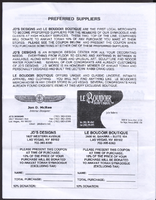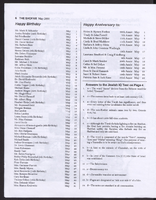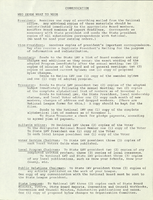Search the Special Collections and Archives Portal
Search Results

J. K. Russ oral history interview: transcript
Date
Archival Collection
Description
Oral history interview with J. K. Russ conducted by Claytee D. White on December 22, 2017 for the Remembering 1 October Oral History Project. In this interview, Russ discusses her early life in New Zealand and growing up on a tobacco farm. She remembers arriving to the United States and establishing a career as an artist. Russ talks about the 1 October shooting, creating an art exhibit using cards and letters received from people all over the world, and Las Vegas’ response to the tragedy. Lastly, Russ describes the art community in Las Vegas and the Arts District.
Text
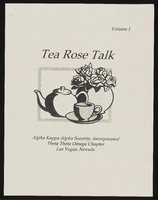
Alpha Kappa Alpha Sorority, Theta Theta Omega Chapter "Tea Rose Talk" newsletters
Date
Archival Collection
Description
From the Alpha Kappa Alpha Sorority, Incorporated, Theta Theta Omega Chapter Records (MS-01014) -- Chapter records file.
Text

Alpha Kappa Alpha Sorority, Theta Theta Omega Chapter scrapbook
Date
Archival Collection
Description
From the Alpha Kappa Alpha Sorority, Incorporated, Theta Theta Omega Chapter Records (MS-01014).
Mixed Content
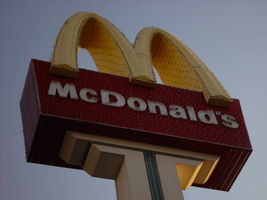
Photographs of McDonald's sign, 2800 S Las Vegas Blvd, Las Vegas (Nev.), 2002
Date
Archival Collection
Description
Site address: 2800 S Las Vegas Blvd
Sign details: Located just south of the Westward Ho's south parking lot is the third and northern most version of the sign. Unlike its other two relatives, this sign is solely designated to the McDonald's establishment. It is located in a small landscaped area directly east of the front of the restaurant. This section essentially comprises the front of the establishment itself. It stands tall on the west side of the strip facing north south.
Sign condition: Structure 5 Surface 4 Lighting 4 It is noted that the structural integrity is intact. Certain elements of lighting are out or not working but still present. The surface appears to be slightly deteriorating at this point.
Sign form: Pylon
Sign-specific description: The odd member of the three McDonald's pylons is different in almost every aspect, considering the similarity of the first two to each other. The sign construction itself is a more sleek, opting to integrate the entire structure into a much smoother design than the previous design as well. The other two cabinets are impressive indeed, but the placement of the cabinets is less clumsy than the others. The pole itself is thinner, painted brown steel flat post, which rises into the air, recording a small rectangular anomaly in the vertical line, which is used to support a yellow plastic internally lit cabinet. The four-sided shape swells out on each side, but transitions smoothly as the vertical shot continues upward. The brown post T's off to either side actually stretching to the widest point of the sign. It then grows vertically once again to create the sides of the cabinet. The shape that the brown portion creates is now more akin to a "U" shape rather than a "T." The entire surface of the pylon which is designated brown in laced with incandescent bulbs. Inside this U shape the face of the cabinet is designated red, and set higher above the surface plain of the face. The red fluted steel face is adorned with vertical neon bars and white channel letters floating above the surface. The channel letters are filled with bars of white neon. The giant golden arches break up the top edge of the red cabinet. The arches themselves are yellow painted steel, whose face are encrusted with yellow incandescent bulbs as well as border of yellow neon which floats around the edge of the arch. The tops and bottom surfaces are finished in a reflective, gold, polished metal. A channel runs up the center of the post and a yellow tube of neon glows as a centering stripe. This stripe actually ties in the internally lit yellow sign, with the crowning arches, quite well.
Sign - type of display: Neon; Incandescent; Backlit
Sign - media: Steel; Plastic
Sign - non-neon treatments: Paint
Sign animation: Oscillating, flashing
Notes: The white incandescent bulbs on the face of the sign illuminate in a chasing pattern from bottom to top, leaving all the bulbs illuminated in it's path, oscillating as they are illuminated. The post vertically illuminates, and when the bulbs reach the top of the brown arms of the U shape, the vertical, red, neon bars on the red portion of the cabinet, chase in simultaneously from either side. They meet in the middle leaving all the bars and thus the cabinet fully illuminated. The cabinet stays lit for a few moments, then the bars curtain out from the middle, back to either side, leaving the bars dark in the animations path. Once they reach the edge, the incandescent bulbs follow suit, and chase back down to the bottom, leaving all the bulbs dark it the chasing path. The yellow incandescent bulbs, which are on the face of the golden arches, constantly oscillate during the animations sequence.
Sign environment: As compared to the other two properties, the environment of this McDonald's is quite different. The other two were integrated into the strip mall design, utilizing the pylon itself for other advertisements as well. Even though the McDonald's pylon stood out as the dominant figure among their surroundings, They still felt as if they were part of a whole as well. The environment, which the northern pylon portrays, also reflects its surroundings as well. This environment of the Westward Ho, the Stardust, the Riviera, and the Circus Circus, bring about a certain garish nature in its design that fits in present in the McDonald's pylon.( see artistic significance and theme for further).
Sign manufacturer: YESCO
Sign - thematic influences: The theme of the McDonald's establishment is in the realm of the well-established McDonalds corporation. The golden arches, and solid red hue, have become synonymous with the name "McDonald's," and is an image, which has been communicated to the masses of people for half a century. It is an icon that is associated with America all over the world. McDonalds has created it's own realm and thematic influence over the years from all of it's extensive advertisements and marketing. Therefore, the theme of the establishment's signs draws from itself and the world, which the name has created. Being one of the most commonly seen images in America, this sign is tailored to fit into the illustrious, illuminative properties held on the Las Vegas Strip. It fits into the category of everyday images and businesses dressed up for Las Vegas, which include, Arabia's, Arco AM/PM, Walgreen's, and Fatburger.
Sign - artistic significance: Besides what is mentioned in the above paragraph about the above nature of the iconography of the said logo, this particular sign draws off of its surroundings to display certain aesthetic elements.
Surveyor: Joshua Cannaday
Survey - date completed: 2002
Sign keywords: Oscillating; Flashing; Pylon; Neon; Incandescent; Backlit; Steel; Plastic; Paint
Mixed Content
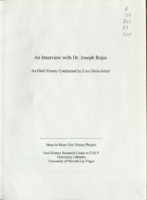
Transcript of interview with Dr. Joseph Rojas by Lisa Gioia-Acres, September 30, 2008
Date
Archival Collection
Description
Dr. Joseph Rojas, born 1933 in Alexandria, Louisiana, was the son of Joseph Edward Rojas and wife Carroll. He graduated high school at age 16 and entered Loyola University of the South. Two years later he was accepted at Louisiana State University School of Medicine, graduating with a medical degree in 1957. He interned at Charity Hospital and then completed his OB-GYN residency at Tulane University. Several mentors worked with Dr. Rojas during his residency and he recalls learning surgical and bed-side skills from the likes of Dr. Lynn White and Dr. Fred Janson. He also remembers the very high volume of patients - up to 300 - that he and other residents saw daily. Dr. Rojas married Mona Robicheaux, RN, during his residency and afterwards joined the Air Force. He and his family — they eventually had six children — were stationed at Nellis Air Force Base, arriving in Las Vegas in 1961. He was chief of OBGYN and deputy hospital commander while at Nellis and then served as chief of OBGYN at Southern Nevada Memorial Hospital until 1972. He later served as chief of staff at Women's Hospital and Valley Hospital, and was the first chief of staff at Summerlin Hospital. Dr. Rojas also maintained a private practice outside of the hospital. His wife worked alongside him in his office, and they share memories and anecdotes of the patients they saw and the general atmosphere of the medical community. Both Joseph and Mona agree that Las Vegas hospitals were less racially segregated than the hospitals in Louisiana, and felt that the West was more open to integration. In 1966 Dr. Rojas started the first OB-GYN residency in Nevada, which led to the development of the University of Nevada School of Medicine. He was a researcher, lecturer, teacher, and author. He earned many awards, including the Harold Feikes MD Award for Outstanding Physician in Clark County (2001), and the Nevada State Medical Association Distinguished Physician Award (1980). Dr. Rojas passed away in May of 2009, leaving behind an incredible legacy of service to the residents of Clark County.
Text

Kaku Makino and Masako "Julie" Ishitsuka oral history interview: transcript
Date
Archival Collection
Description
Oral history interview with Kaku Makino and Masako "Julie" Ishitsuka conducted by Kristel Peralta, Vanessa Concepcion, Ayrton Yamaguchi, and Stefani Evans on March 22, 2021 for the Reflections: The Las Vegas Asian American and Pacific Islander Oral History Project. In this interview, Makino discusses his early life in Tokyo, Japan and becoming a chef. He recalls arriving to the United States in 1989, establishing the Todai (now Makino Sushi & Seafood Buffet) restaurant chain, and opening nineteen locations in California, Florida, and in Hawaii. Kano talks about her upbringing in Otsu, Shiga Prefecture, Japan and describes Japan during the Meiji era. She remembers arriving to Las Vegas, Nevada in 2000 and the cultural change she experienced. Lastly, Makino and Kano discuss the restaurant industry during the COVID-19 pandemic.
Text
Women's Research Institute of Nevada Records
Identifier
Abstract
The Women's Research Institute of Nevada Records (1997-2017) document the establishment and activities of the Women's Research Institute of Nevada (WRIN) at the University of Nevada, Las Vegas (UNLV). The majority of the collection represents research files, correspondence, and other working files kept by Joanne Goodwin, professor of history at UNLV and executive director of WRIN from 1999 to 2017. Materials include information about the creation of WRIN as well as its partnership with the National Education for Women's Leadership program to create NEW Leadership Nevada. Digital files in this collection include WRIN and NEW Leadership event photographs and administrative files used for WRIN operations. Digital files also include copies of annual reports and WRIN newsletters. Also included is a copy of
Archival Collection

